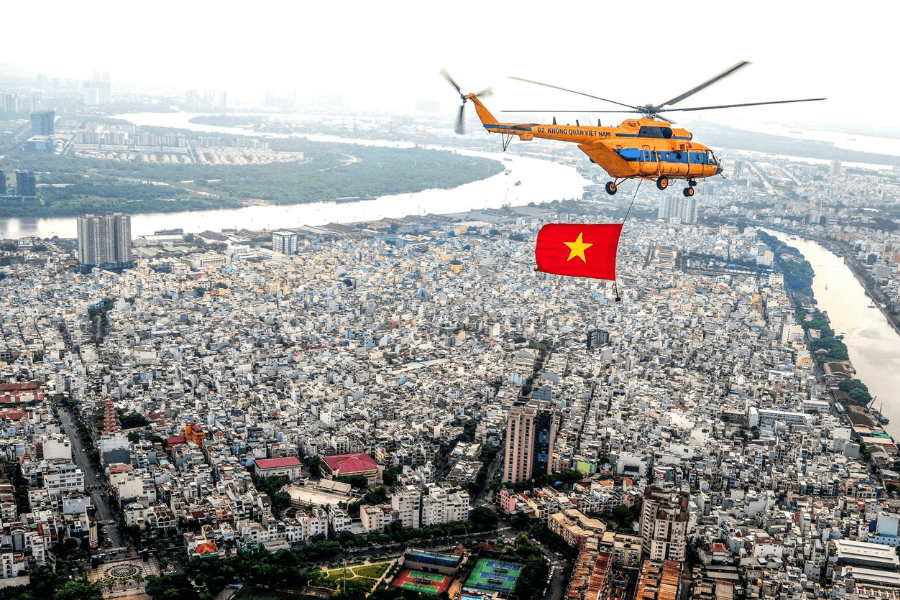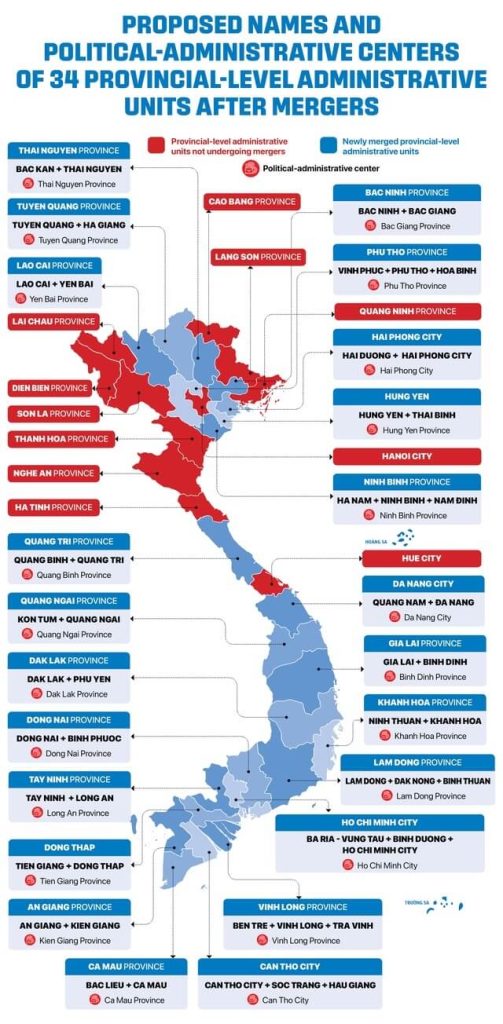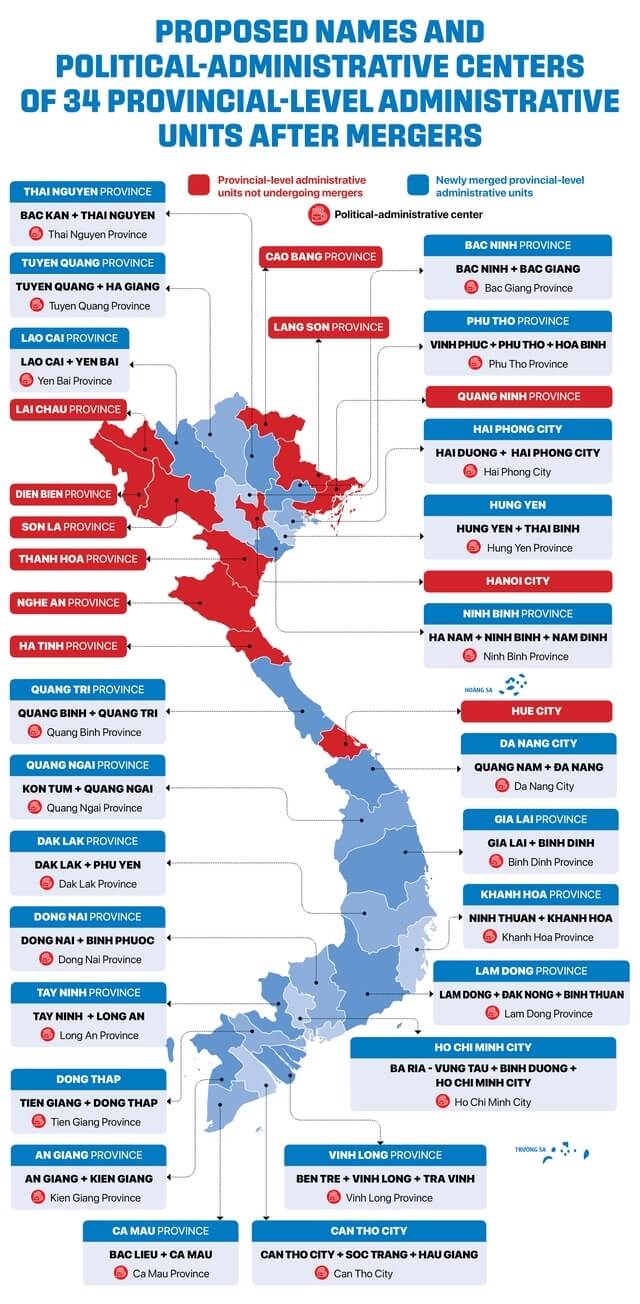Hanoi Travel Blog - Hanoi Introduction & Information
Vietnam Provincial Merger 2025 – All Information & Essential Guide for International Tourists
Explore Vietnam’s 2025 provincial merger, reducing 63 provinces to 34, and its impact on travel. Learn about the new two-tier governance, key destinations, and FAQs for a seamless trip. Plan your Vietnam tours with Hanoi Local Tour today!
Introduction to Vietnam Provincial Merger
Vietnam is embarking on a transformative journey with the Vietnam provincial merger, a landmark reform set to reshape its administrative landscape starting July 1, 2025. This ambitious initiative, formalized through Resolution No.202/2025/QH15 by the 11th plenum of the 13th Party Central Committee under Party General Secretary To Lam, consolidates Vietnam’s 63 provincial-level administrative units into 34, comprising 28 provinces and 6 centrally governed cities. This restructuring, part of Vietnam’s Governance Reform and Provincial Mergers, aims to streamline governance, boost economic efficiency, and enhance public service delivery by eliminating district-level administrations and adopting a two-tier local government system.
For international travelers, this reform is more than a bureaucratic shift—it’s an opportunity to explore a reimagined Vietnam. The merger creates larger, more diverse regions, blending urban vibrancy, cultural heritage, and natural wonders. From Hanoi’s enduring charm to the newly expanded Ho Chi Minh City, this guide provides a detailed look at how the Vietnam provincial merger affects tourism, offering practical tips to navigate the new administrative map. Whether you’re planning a cultural dive into Hanoi’s Old Quarter or an adventure in the merged provinces like Lao Cai, understanding these changes will enrich your travel experience.
Timeline of Vietnam Provincial Merger
- June 12, 2025: The National Assembly officially passed the amended resolution and Law on Local Government Organization, setting July 1, 2025, as the effective date for the Vietnam provincial merger.
- June 30, 2025: All 34 new and unchanged provincial-level units announced their leadership structures, ensuring a smooth transition. The Vietnam Department of Survey, Mapping, and Geographic Information released updated digital maps reflecting the new boundaries.
- July 1, 2025: The Vietnam provincial merger and two-tier governance system took effect, dissolving district-level administrations and reducing commune-level units by 60–70%. This marked the official start of the new administrative era.
This timeline underscores Vietnam’s meticulous approach to reform, ensuring stability and transparency as the country transitions to a leaner administrative system.
Overview of the New Two-Tiered Local Government System
The cornerstone of Vietnam’s Governance Reform and Provincial Mergers is the adoption of a two-tier local government system, effective July 1, 2025. This system eliminates the district-level administrative layer, streamlining governance into two levels: provincial (provinces and centrally governed cities) and commune (communes, wards, and special zones). Here’s a detailed breakdown:
Key Features of the Two-Tier System
- Provincial Level: Comprises 34 units (28 provinces and 6 centrally governed cities, including Hanoi, Ho Chi Minh City, Hai Phong, Da Nang, Can Tho, and the new Thai Nguyen). Provincial authorities handle major administrative tasks, such as economic planning, infrastructure development, and 15 land-related procedures, including land-use rights transfers.
- Commune Level: Manages local services, such as issuing first-time land-use certificates and supporting community-level tourism initiatives. The reform reduces commune-level units by 60–70%, creating larger, more efficient communes.
- Elimination of Districts: The dissolution of district-level administrations reduces bureaucratic overlap, saving an estimated $7.3 billion by 2030, according to posts on X. This allows for faster decision-making and improved public service delivery.
Benefits for Travelers
- Simplified Processes: Tourists will encounter fewer administrative hurdles when arranging permits, visas, or local registrations. Provincial offices in cities like Hanoi now centralize these services.
- Enhanced Connectivity: Larger provinces facilitate better infrastructure, such as highways and public transport, making it easier to travel between urban and rural areas.
- Local Engagement: Commune-level authorities are adopting digital tools to improve service delivery, ensuring smoother interactions for visitors seeking local tours or homestays.
According to Permanent Deputy Prime Minister Nguyen Hoa Binh, this system brings governance closer to the people, enhancing efficiency and accessibility. For travelers, this translates to a more seamless experience when exploring Vietnam’s diverse regions.
List of Newly Vietnam Merged Provinces and Cities
| Merged Units | New Province/City | New Admin Center |
| Tuyen Quang + Ha Giang | Tuyen Quang | Tuyen Quang City |
| Lao Cai + Yen Bai | Lao Cai | Yen Bai City |
| Bac Kan + Thai Nguyen | Thai Nguyen | Thai Nguyen City |
| Vinh Phuc + Phu Tho + Hoa Binh | Phu Tho | Viet Tri City |
| Bac Ninh + Bac Giang | Bac Ninh | Bac Giang City |
| Hung Yen + Thai Binh | Hung Yen | Hung Yen City |
| Hai Duong + Hai Phong | Hai Phong | Hai Phong City |
| Ha Nam + Ninh Binh + Nam Dinh | Ninh Binh | Ninh Binh City |
| Quang Binh + Quang Tri | Quang Tri | Dong Hoi City |
| Quang Nam + Da Nang | Da Nang | Da Nang City |
| Kon Tum + Quang Ngai | Quang Ngai | Quang Ngai City |
| Gia Lai + Binh Dinh | Gia Lai | Quy Nhon City |
| Ninh Thuan + Khanh Hoa | Khanh Hoa | Nha Trang City |
| Lam Dong + Dak Nong + Binh Thuan | Lam Dong | Da Lat City |
| Dak Lak + Phu Yen | Dak Lak | Buon Ma Thuot City |
| Ba Ria-Vung Tau + Binh Duong + HCMC | Ho Chi Minh City | Ho Chi Minh City |
| Dong Nai + Binh Phuoc | Dong Nai | Bien Hoa City |
| Tay Ninh + Long An | Tay Ninh | Tan An City |
| Can Tho + Soc Trang + Hau Giang | Can Tho | Can Tho City |
| Ben Tre + Vinh Long + Tra Vinh | Vinh Long | Vinh Long City |
| Tien Giang + Dong Thap | Dong Thap | My Tho City |
| Bac Lieu + Ca Mau | Ca Mau | Ca Mau City |
| An Giang + Kien Giang | An Giang | Rach Gia City |
Vietnam Provinces That Will Remain Unchanged
Eleven provincial-level units remain unaffected by the Vietnam provincial merger, offering continuity for travelers familiar with these destinations:
- Hanoi: Vietnam’s capital, renowned for Hoan Kiem Lake, the Temple of Literature, and vibrant street food scenes.
- Hue: A cultural gem with the Imperial City and Perfume River, a UNESCO World Heritage Site.
- Lai Chau: A northern province known for Sin Ho’s ethnic markets and rugged landscapes.
- Dien Bien: Famous for the Dien Bien Phu Victory site and ethnic diversity.
- Son La: Home to Moc Chau’s tea plantations and cultural festivals.
- Cao Bang: Features Ban Gioc Waterfall and Pac Bo Cave, a historical site.
- Lang Son: A gateway to China with vibrant border markets like Tan Thanh.
- Quang Ninh: Boasts Ha Long Bay, a UNESCO World Heritage Site, and Yen Tu’s spiritual sites.
- Thanh Hoa: Known for Sam Son Beach and Ho Citadel.
- Nghe An: Birthplace of Ho Chi Minh, with cultural sites like Kim Lien Village.
- Ha Tinh: Offers historical sites like Nguyen Du’s hometown and Ke Go Lake.
These provinces provide a stable foundation for travelers, with well-established tourism infrastructure and iconic attractions.
Impact of Vietnam Provincial Merger on Travelers and Tourism
The Vietnam provincial merger introduces a range of advantages that enhance the travel experience for foreign visitors, from streamlined processes to enriched tourism opportunities and improved infrastructure. These benefits align with Vietnam’s goal of becoming a more accessible and competitive global tourism destination.
Simplified Administrative Processes
The elimination of district-level administrations centralizes key services at the provincial and commune levels, making interactions with local authorities more efficient. This is a significant advantage for international travelers, who often face bureaucratic hurdles in unfamiliar destinations.
Enhanced Infrastructure and Connectivity
The creation of larger, economically viable provinces under Vietnam’s Governance Reform and Provincial Mergers has spurred investments in infrastructure, improving access to both urban hubs and remote destinations. This enhances connectivity and convenience for tourists.
Enriched Tourism Opportunities
The Vietnam provincial merger creates larger, more diverse regions by combining urban, rural, and coastal areas, offering international travelers a broader range of experiences within a single province. This integration enhances Vietnam’s appeal as a multifaceted destination.
Economic and Tourism Industry Growth
The Vietnam provincial merger enhances Vietnam’s economic competitiveness, with direct benefits for tourism. According to the Vietnam Private Sector Forum 2025, a new tool to evaluate provincial business friendliness will encourage tourism-friendly policies, such as streamlined licensing for hotels and tour operators.
Hanoi as a Stable Tourism Hub
As one of the 11 unchanged provinces, Hanoi remains a reliable base for exploring the impacts of Vietnam’s Governance Reform and Provincial Mergers. Its world-class infrastructure, including Noi Bai International Airport and a robust network of tour operators, makes it ideal for planning multi-destination trips. These benefits collectively make Vietnam a more accessible, diverse, and traveler-friendly destination, enhancing the overall experience for international visitors.
Join Hanoi Local Tour to explore more exciting Hanoi tours!
Practical Tips For Travelers After Vietnam Provincial Merger 
To maximize the benefits and mitigate the limitations of the Vietnam provincial merger, international travelers should consider the following:
- Update Navigation Tools: Ensure apps like Google Maps reflect the new 34 provinces. Download the Vietnam Department of Survey’s digital map (map.vietnam.vn) for offline use.
- Plan with Flexibility: Allow extra time for administrative tasks or travel in rural areas during the transition period (July–December 2025). Booking through established operators in Hanoi can streamline arrangements.
- Embrace Cultural Diversity: Learn about the ethnic groups and festivals in merged provinces. For example, in An Giang, visit Khmer pagodas with a guide to understand local customs.
Frequently Asked Questions about Vietnam Provincial Merger(FAQs)
1. What is the Vietnam provincial merger?
The Vietnam provincial merger is a 2025 reform reducing Vietnam’s 63 provincial-level units to 34, effective July 1, 2025. It eliminates district-level administrations and adopts a two-tier governance system (provincial and commune levels) to enhance efficiency.
2. How does the merger affect travel to Hanoi?
Hanoi remains unchanged, maintaining its status as a tourism hub. The merger simplifies administrative processes like visa extensions and enhances connectivity to nearby provinces like Phu Tho, making Hanoi a strategic base for exploration.
3. Which provinces are unaffected by the merger?
Eleven provinces remain unchanged: Hanoi, Hue, Lai Chau, Dien Bien, Son La, Cao Bang, Lang Son, Quang Ninh, Thanh Hoa, Nghe An, and Ha Tinh.
4. How will the new provinces impact tourism?
The merger creates larger, more diverse regions, offering richer travel experiences. For example, the new Ho Chi Minh City combines urban attractions, industrial zones, and beaches, while Lao Cai offers trekking and cultural immersion.
5. Are there new travel requirements due to the merger?
No new requirements have been announced, but travelers should update navigation tools and check with provincial offices for permits. Hanoi’s immigration services remain consistent for visa needs.
6. How can I navigate the new administrative map?
The Vietnam Department of Survey, Mapping, and Geographic Information provides updated digital maps at map.vietnam.vn. Ensure your GPS apps reflect the new 34 provinces.





